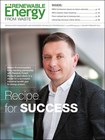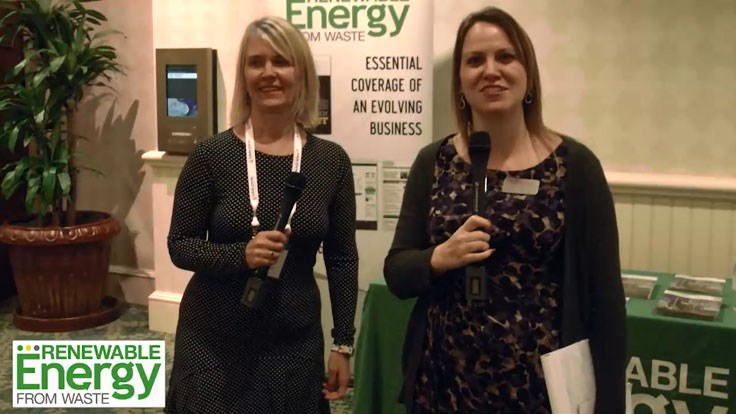| Michael Theroux of JDMT Inc., addresses attendees of the Waste Conversion Technology Conference. Seated are session panelist Susan Robinson of Waste Management and moderator Steve Torres, Pannone Lopes Devereaux & West. |
Public-private partnerships (PPPs), the changing waste stream and building a roadmap for sustainable waste management were just some of the topics addressed during the opening session of the 2015 Waste Conversion Technology Conference, held in San Diego in August.
A panel including Michael Theroux of Cheyenne, Wyoming-based JDMT Inc.; Susan Robinson of Houston-based Waste Management (WM) and Patrick Holland of the County of Los Angeles Department of Public Works took a look at the various aspects of projects, including the materials themselves, and how to turn those materials into a successful and sustainable program that makes sense.
Theroux referred to what he called “public private synergies.” He said there is a difference between a public private synergy and a PPP. “Just because you are in a partnership doesn’t mean it’s synergistic,” he commented.
He gave three examples of PPPs and synergy centers. The first example was the Solid Waste Authority of Central Ohio (SWACO), Grove City, Ohio, and developer Team Gemini, a Florida-based company. The project was to be one of the largest material recovery facilities in the country and also produce products and energy from the waste and recyclables, but the project has stalled.
Theroux said the developer Doug Haughn, blamed the PPP for the delays because of changing administration and leadership, which meant having to start the process over and over again.
“The public private partnership is both our nemesis and our saving grace,” says Theroux.
A more successful example he gave was a project with the city of Philadelphia and Emerson to to increase the amount of food waste going to the waste water treatment plant by installing Emerson’s Insinkerator disposals in households that lacked them in order to assess the impact on food waste diversion.
According to Theroux, without changing the infrastructure, food waste was reduced by 30 percent and it doubled the amount of biogas coming out of the waste water treatment plant’s digesters.
Another successful project he pointed to is located in Denmark. Kalundborg Symbiosis is a collaboration between private companies, public companies and Kalundborg Municipality to facilitate sustainable production. Thirty different companies, agencies and institutions are part of the Symbiosis. Last year, the project also added an eco-industrial tourist complex.
“This is to me my idea of the state-of-the-art in resource recovery and waste conversion,” he said.
Robinson outlined WM’s involvement in the waste conversion industry. The $14 billion waste environmental services company started venturing into the new technology field about nine years ago and has about 30 investments today.
She noted how the waste stream has changed dramatically in the past 20 years. “We should all pay attention to the changing waste stream and what it means for the materials we are managing,” she said.
Robinson said while recycling is WM’s first priority as it has the greatest impact on the environment, at the end of the day, there are many materials that cannot be recycled or managed in other ways. Referring to waste conversion technologies, she said, “And that so often is what these technologies bring to the table and why they are so important that we continue to invest in them.”
She said new products that are designed to reduce greenhouse emissions also can’t be recycled.
Robinson talked about the growth in the volume of waste in the 1960s, 1970s and 1980s and that it reached its peak in 2000. Since 2005, waste generation has been on the decline. In 2013, Robinson said, the U.S. disposed of less waste per person than we did in 1950, and disposed of the same amount of tons in 2013 than it did in 1980. “A lot of that is because of the changes in technology and the materials we are using,” she said.
“We have a lot of shifting in materials in the waste stream and we can’t not pay attention to them,” said Robinson. She said that 25 percent of the waste stream is packaging and that plastic is growing in prevalence as is cardboard. That growth, represents a big shift in those materials in the last 20 years, she said.
She also showed how in the last 10 years, newsprint has declined by 50 percent and 20 percent less paper overall is in the waste stream, while same time plastic has continued to rise.
“If you think in the context in technology, the shift in the waste stream because of plastic is dramatic,” she emphasized. She also explained that because of light weighting, more units of packaging exist but they weigh less than they did prior to the shift to flexible packaging.
She said flexible pouches are experiencing a 4-7 percent growth per year, replacing materials that used to be recyclable. According to Robinson, 53 percent of waste stream used to be made up of recyclable material, but now an increasing percentage of the waste stream is organics. It is the single largest remaining piece of the waste stream, she said.
According to Robinson, when it comes to conversion technologies, “the single biggest hurdle that we face is the heterogeneity of the waste stream.” She adds that at WM, “Our due diligence really focuses on understanding that and when we are looking at companies, we are looking at whether that has been accommodated in the actual technology itself.”
WM has begun focusing on what Robinson calls “discreet materials” where the company is “slicing and dicing” the waste stream to solve its customers’ problems with specific types of waste. Of the 30 waste conversion technology companies WM is investing in, 21 percent are wholly owned; 17 percent are majority owned; and 58 percent are minority owned.
As for the types of technologies WM is investing in Robinson said, “We are heavy on gasification, which is actually not really where we want to be.” She adds, “We have really tried to over the last couple of years going back over to things that are closer to our core competencies and closer towards commercialization.”
The core competencies include next-generation technologies that complement existing competencies in recycling, organics, landfill gas to energy, and waste-to-energy, Robinson explained.
Examples of core competencies are gas and liquid fuels from the company’s existing landfills or its solid fuel product, SpecFUEL. The company is also involved in a project with Los Angeles County to create a slurry from commercial food waste to be used in a waste water treatment plant digester. Another one third of WM’s investments are also what Robinson describes as “bleeding edge technologies.”
As far as end markets for the energy and fuel products produced from a conversion process, Robinson notes it is very difficult to break into as it is often new to the end user. “It is a lot more work and we are a lot more vulnerable moving into those places than we are in an industry we’ve been working in for decades,” she said.
The county of Los Angeles’ Holland discussed the city and county’s advancement toward conversion technologies. He pointed to several assembly bills (ABs) in the state of California that encourage the development of these technologies, including AB 341 (2011), which requires the commercial sector to recycle and a Statewide 75 percent recycling goal by 2020; and AB 1826 (2014) which requires commercial entities to recycle their organic waste.
The board of supervisors in LA County also adopted the Roadmap to Sustainable Waste Management Future which he said “set very aggressive diversion targets.” This includes a target of 80 percent waste diversion by 2025, 90 percent by 2035 and 95 percent by 2045.
The four major strategies to implement the roadmap includes:
- quality programs and services;
- measuring results;
- facilities and infrastructure; and
- outreach and education.
He said the county wants to help facilitate the development of conversion technologies, promoting an integrated approach. Excess capacity at waste water treatment plants is one opportunity. He also said the county wants to streamline the permitting process.
“We want to see these projects get built in Los Angeles County and in Southern California and the state of California,” he said.
The 2015 Waste Conversion Technology Conference was Aug. 17-19 at the Hyatt Regency Mission Bay Spa & Marina in San Diego.



